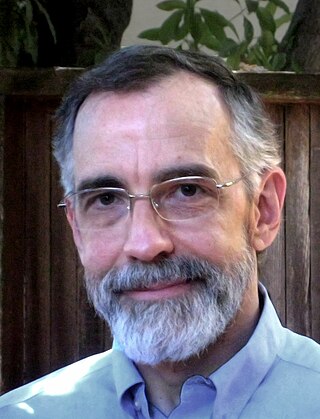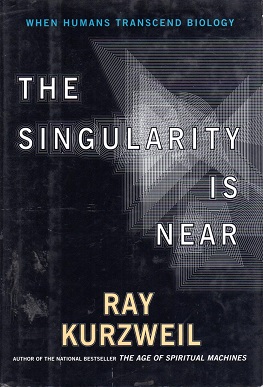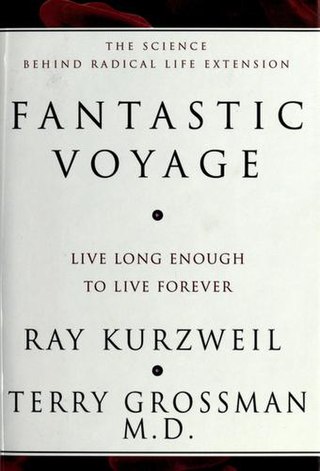Related Research Articles

William Nelson Joy is an American computer engineer and venture capitalist. He co-founded Sun Microsystems in 1982 along with Scott McNealy, Vinod Khosla, and Andy Bechtolsheim, and served as Chief Scientist and CTO at the company until 2003.

Kim Eric Drexler is an American engineer best known for introducing molecular nanotechnology (MNT), and his studies of its potential from the 1970s and 1980s. His 1991 doctoral thesis at Massachusetts Institute of Technology (MIT) was revised and published as the book Nanosystems: Molecular Machinery Manufacturing and Computation (1992), which received the Association of American Publishers award for Best Computer Science Book of 1992. He has been called the "godfather of nanotechnology".

Raymond Kurzweil is an American computer scientist, author, inventor, and futurist. He is involved in fields such as optical character recognition (OCR), text-to-speech synthesis, speech recognition technology and electronic keyboard instruments. He has written books on health technology, artificial intelligence (AI), transhumanism, the technological singularity, and futurism. Kurzweil is a public advocate for the futurist and transhumanist movements and gives public talks to share his optimistic outlook on life extension technologies and the future of nanotechnology, robotics, and biotechnology.
The technological singularity—or simply the singularity—is a hypothetical future point in time at which technological growth becomes uncontrollable and irreversible, resulting in unforeseeable consequences for human civilization. According to the most popular version of the singularity hypothesis, I. J. Good's intelligence explosion model, an upgradable intelligent agent will eventually enter a positive feedback loop of self-improvement cycles, each new and more intelligent generation appearing more and more rapidly, causing a rapid increase ("explosion") in intelligence which ultimately results in a powerful superintelligence that qualitatively far surpasses all human intelligence.

The Age of Spiritual Machines: When Computers Exceed Human Intelligence is a non-fiction book by inventor and futurist Ray Kurzweil about artificial intelligence and the future course of humanity. First published in hardcover on January 1, 1999, by Viking, it has received attention from The New York Times, The New York Review of Books and The Atlantic. In the book Kurzweil outlines his vision for how technology will progress during the 21st century.

Mind uploading is a speculative process of whole brain emulation in which a brain scan is used to completely emulate the mental state of the individual in a digital computer. The computer would then run a simulation of the brain's information processing, such that it would respond in essentially the same way as the original brain and experience having a sentient conscious mind.
The Omega Point is a theorized future event in which the entirety of the universe spirals toward a final point of unification. The term was invented by the French Jesuit Catholic priest Pierre Teilhard de Chardin (1881–1955). Teilhard argued that the Omega Point resembles the Christian Logos, namely Christ, who draws all things into himself, who in the words of the Nicene Creed, is "God from God", "Light from Light", "True God from True God", and "through him all things were made". In the Book of Revelation, Christ describes himself three times as "the Alpha and the Omega, the beginning and the end". Several decades after Teilhard's death, the idea of the Omega Point was expanded upon in the writings of John David Garcia (1971), Paolo Soleri (1981), Frank Tipler (1994), and David Deutsch (1997).
Singularitarianism is a movement defined by the belief that a technological singularity—the creation of superintelligence—will likely happen in the medium future, and that deliberate action ought to be taken to ensure that the singularity benefits humans.

The Singularity Is Near: When Humans Transcend Biology is a 2005 non-fiction book about artificial intelligence and the future of humanity by inventor and futurist Ray Kurzweil.

Peter H. Diamandis is an American marketer, engineer, physician, and entrepreneur of Greek-American ethnicity. He is best known for being founder and chairman of the X Prize Foundation, cofounder and executive chairman of Singularity University and coauthor of The New York Times bestsellersAbundance: The Future Is Better Than You Think, The Future is Faster than You Think, How Converging Technologies Are Transforming Business, Industries, and Our Lives and BOLD: How to Go Big, Create Wealth, and Impact the World. He is former CEO and cofounder of the Zero Gravity Corporation, cofounder and vice chairman of Space Adventures Ltd., founder and chairman of the Rocket Racing League, cofounder of the International Space University, cofounder of Planetary Resources, cofounder of Celularity, founder of Students for the Exploration and Development of Space, vice chairman and cofounder of Human Longevity, Inc.

The Age of Intelligent Machines is a non-fiction book about artificial intelligence by inventor and futurist Ray Kurzweil. This was his first book and the Association of American Publishers named it the Most Outstanding Computer Science Book of 1990. It was reviewed in The New York Times and The Christian Science Monitor. The format is a combination of monograph and anthology with contributed essays by artificial intelligence experts such as Daniel Dennett, Douglas Hofstadter, and Marvin Minsky.

Fantastic Voyage: Live Long Enough to Live Forever is a book authored by Ray Kurzweil and Terry Grossman published in 2004. The basic premise of the book is that if middle aged people can live long enough, until approximately 120 years, they will be able to live forever—as humanity overcomes all diseases and old age itself. This might also be considered a break-even scenario where developments made during a year increase life expectancy by more than one year. Biogerontologist Aubrey de Grey called this the "Longevity escape velocity" in a 2005 TED talk.
In futures studies and the history of technology, accelerating change is the observed exponential nature of the rate of technological change in recent history, which may suggest faster and more profound change in the future and may or may not be accompanied by equally profound social and cultural change.
An artificial brain is software and hardware with cognitive abilities similar to those of the animal or human brain.

In the life extension movement, longevity escape velocity (LEV), actuarial escape velocity or biological escape velocity is a hypothetical situation in which one's remaining life expectancy is extended longer than the time that is passing. For example, in a given year in which longevity escape velocity would be maintained, medical advances would increase people's remaining life expectancy more than the year that just went by.

Transcendent Man is a 2009 documentary film by American filmmaker Barry Ptolemy about inventor, futurist and author Ray Kurzweil and his predictions about the future of technology in his 2005 book, The Singularity is Near. In the film, Ptolemy follows Kurzweil around his world as he discusses his thoughts on the technological singularity, a proposed advancement that will occur sometime in the 21st century when progress in artificial intelligence, genetics, nanotechnology, and robotics will result in the creation of a human-machine civilization.
This list compares various amounts of computing power in instructions per second organized by order of magnitude in FLOPS.

Our Final Invention: Artificial Intelligence and the End of the Human Era is a 2013 non-fiction book by the American author James Barrat. The book discusses the potential benefits and possible risks of human-level or super-human artificial intelligence. Those supposed risks include extermination of the human race.

Unity Biotechnology is a publicly traded American biotechnology company that develops drugs that target senescent cells.

José Luis Cordeiro Mateo is a Venezuelan-Spanish engineer, economist, futurist, and transhumanist, who has worked on areas including economic development, international relations, Latin America, the European Union, monetary policy, comparison of constitutions, energy trends, cryonics, and life extension. Books he has written include The Great Taboo, Constitutions Around the World: A Comparative View from Latin America, and El Desafio Latinoamericano, and La Muerte de la Muerte.
References
- ↑ Kuzwell, Ray. "The Singularity is Nearer". Penguin. Retrieved 13 April 2024.
- ↑ Hill, David J. (2015-06-05). "Exponential Finance: Ray Kurzweil Stresses Humanity's 'Moral Imperative' in Developing Artificial Intelligence". Singularity Hub. Retrieved 2020-10-10.
- ↑ Sullivan, Danny (2020-05-20). "Longevity and the Singularity - Longevity.Technology - Latest News, Opinions, Analysis and Research". Longevity.Technology - Latest News, Opinions, Analysis and Research. Retrieved 2024-04-18.
- ↑ Kurzweil, Ray (2020-01-01). "celebrating: 15 year anniversary of the book the Singularity Is Near" . Retrieved 2024-04-18.
- ↑ Smith, Daniel S. (2024-03-07). "The Singularity is Nearer". The Times of Israel . Retrieved 2024-03-26.
- ↑ "Conversations with Maya: Ray Kurzweil | Society for Science & the Public" . Retrieved 2020-10-10.
- ↑ "Conversations with Maya: Ray Kurzweil". Science News. Retrieved 2020-10-10.